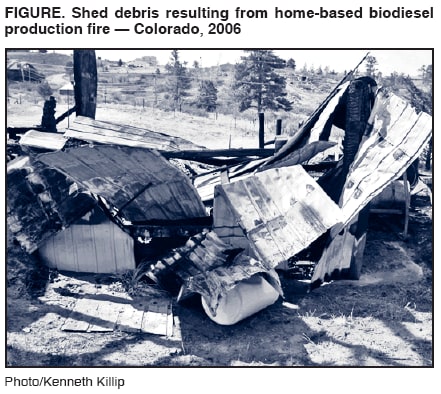 |
|
|
|
|
|
|
| ||||||||||
|
|
|
|
|
|
|
||||
| ||||||||||
|
|
|
|
|
Persons using assistive technology might not be able to fully access information in this file. For assistance, please send e-mail to: mmwrq@cdc.gov. Type 508 Accommodation and the title of the report in the subject line of e-mail. Brief Report: Hazardous Materials Release Resulting from Home Production of Biodiesel --- Colorado, May 2006On May 7, 2006, a hazardous materials (HazMat) release occurred in a residential area of Colorado when a homeowner who was processing a tank of homemade biodiesel fuel forgot to turn off the tank's heating element and left for the weekend. The heating element overheated and caused a fire that burned the surrounding shed and equipment (Figure). The shed had contained >600 gallons of biodiesel and recycled restaurant cooking oil, smaller amounts of glycerin and sodium hydroxide, and 1-gallon containers of sulfuric and phosphoric acid; a mixture of these ingredients seeped into the ground during the fire. A certified HazMat team and the local fire department responded. Investigators found seven 55-gallon barrels of methanol and other hazardous materials outside the shed. No injuries or evacuations occurred. To prevent potential injuries, biodiesel should be purchased from a licensed commercial source. The recent rise in petroleum prices has caused an increased interest in alternative fuels such as biodiesel (1). Although many alternative fuels exist (e.g., ethanol, hydrogen, and natural gas), biodiesel is used increasingly as a diesel-replacement fuel in the United States because it can be manufactured from readily available ingredients such as vegetable oil, animal fat, or recycled restaurant cooking oil (2). Biodiesel is created through a chemical process involving the reaction of fat or oil with methanol in the presence of a catalyst (e.g., sodium or potassium hydroxide) to produce methyl ester (i.e., biodiesel) and glycerin, a byproduct used in soap and other products (3,4). Biodiesel can be used in vehicles and machinery designed to operate on diesel fuel, such as automobiles with diesel (but not gasoline) engines, fuel and heating-oil boilers, and nonaviation turbines (3). Biodiesel usually is produced commercially; however, some persons in the United States and elsewhere produce biodiesel in their homes for personal use. Those who produce homemade biodiesel should be aware of the substantial risk for injury. Substances used in biodiesel production can be highly explosive (i.e., methanol) or corrosive (i.e., sodium hydroxide). If improperly handled, these substances can cause severe eye, skin, and upper respiratory irritation; chemical burns; and other serious injuries (5--7). During the preceding 10 years, almost all fires and injuries caused by home production of biodiesel of which the National Biodiesel Board (NBB) is aware were caused by improper handling of methanol during production. NBB is the nonprofit trade association coordinating regulatory, technical, and market development of the fuel as a commercial product. The event described in this report is the first known to NBB involving a heating element in an unintentional fire related to home production of biodiesel. This HazMat event was reported to the Hazardous Substances Emergency Events Surveillance (HSEES) system operated by the Colorado Department of Health and Environment; HSEES was created by the Agency for Toxic Substances and Disease Registry (ATSDR) (8). This multistate* health department surveillance system tracks morbidity and mortality resulting from events† involving the release of hazardous substances. However, because reporting HazMat events to HSEES is not mandatory, participating state health departments might not be informed about every event. Production of homemade biodiesel can be dangerous for persons without appropriate training and equipment. Therefore, this fuel should be purchased from a licensed source. Reported by: K Killip, Hazardous Materials Response Team, Parker Fire Protection District, Arapaho/Douglas County; C Kelley, Colorado Dept of Health and Environment. S Howell, National Biodiesel Board, Jefferson City, Missouri. DK Horton, MSPH, M Orr, MS, Div of Health Studies, Agency for Toxic Substances and Disease Registry. * Colorado, Florida, Iowa, Louisiana, Michigan, Minnesota, New Jersey, New York, North Carolina, Oregon, Texas, Utah, Washington, and Wisconsin. † An event is defined as a sudden, uncontrolled, or illegal release or threatened release of at least 10 lbs or 1 gallon of a hazardous substance or any amount of a hazardous substance if it is on the mandatory reporting list. References
Figure  Return to top.
Disclaimer All MMWR HTML versions of articles are electronic conversions from ASCII text into HTML. This conversion may have resulted in character translation or format errors in the HTML version. Users should not rely on this HTML document, but are referred to the electronic PDF version and/or the original MMWR paper copy for the official text, figures, and tables. An original paper copy of this issue can be obtained from the Superintendent of Documents, U.S. Government Printing Office (GPO), Washington, DC 20402-9371; telephone: (202) 512-1800. Contact GPO for current prices. **Questions or messages regarding errors in formatting should be addressed to mmwrq@cdc.gov.Date last reviewed: 11/15/2006 |
|||||||||
|